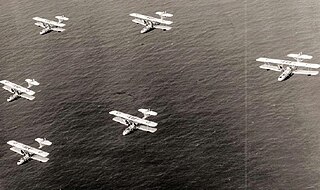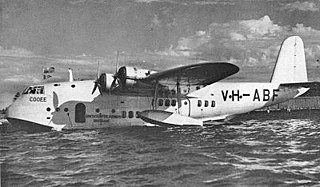
The Fleet Air Arm (FAA) is one of the five fighting arms of the Royal Navy. and is responsible for the operation of naval aircraft. The Fleet Air Arm recently started operating the F-35 Lightning II in a Maritime Strike Role, the AW159 Wildcat and AW101 Merlin in both Commando and Anti-Submarine roles, and the BAE Hawk. Helicopters such as the Lynx and Westland Wasp were previously deployed on smaller vessels since 1964, taking over the roles once performed by biplanes such as the Fairey Swordfish.

The United States Asiatic Fleet was a fleet of the United States Navy during much of the first half of the 20th century. Before World War II, the fleet patrolled the Philippine Islands. Much of the fleet was destroyed by the Japanese by February 1942, after which it was dissolved and incorporated into the naval component of the South West Pacific Area command, which eventually became the Seventh Fleet.

Karel Willem Frederik Marie Doorman was a Dutch naval officer during World War II who commanded remnants of the short-lived American-British-Dutch-Australian Command naval strike forces in the Battle of the Java Sea. He was killed in action when his flagship HNLMS De Ruyter was torpedoed during the battle, having chosen to go down with the ship.

USS Goldsborough (DD-188/AVP-18/AVD-5/APD-32) was a Clemson-class destroyer in the United States Navy during World War II. She was the second Navy ship named for Rear Admiral Louis M. Goldsborough (1805–1877). Entering service in 1920, the ship had a brief active life before being placed in reserve in 1922. Goldsborough was reactivated for World War II and was used as an aircraft tender, destroyer and high speed transport in both Atlantic and Pacific theaters. Following the war, the ship was sold for scrapping in 1946.

USS Childs (DD-241/AVP-14/AVD-1) was a Clemson-class destroyer in the United States Navy during World War II. She was named for Earle W. F. Childs.

Ralph McMaster Rich was an aviator of the United States Navy during World War II.
Norman Francis Vandivier was a United States Navy aviator during World War II. He was posthumously awarded the Navy Cross for action during the Battle of Midway.
Andrew Kenneth Waterman, enlisted in the United States Navy on 21 November 1932 at Buffalo, New York.
Frederick Thomas Weber was a naval aviator in the United States Navy during World War II.
VPB-91 was a Patrol Bombing Squadron of the U.S. Navy. The squadron was established as Patrol Squadron 91 (VP-91) on 1 December 1941, redesignated as Patrol Bombing Squadron 91 (VPB-91) on 1 October 1944 and disestablished on 2 April 1946.

VPB-105 was a Patrol Bombing Squadron of the U.S. Navy. The squadron was established as Patrol Squadron 10 (VP-10) on 29 May 1924, redesignated Patrol Squadron 2D-15 (VP-2D15) on 21 September 1927, redesignated Patrol Squadron 2-S (VP-2S) on 1 July 1931, redesignated Patrol Squadron 2-F (VP-2F) on 17 July 1933, redesignated Patrol Squadron 2 (VP-2) on 1 October 1937, redesignated Patrol Squadron 31 (VP-31) on 1 July 1939, redesignated Bombing Squadron 105 (VB-105) on 15 May 1943, redesignated Patrol Bombing Squadron 105 (VPB-105) on 1 October 1944 and disestablished on 27 June 1945.
VPB-24 was a Patrol Bombing Squadron of the U.S. Navy. The squadron was established as Patrol Squadron 9-S (VP-9S) on 7 January 1930, redesignated Patrol Squadron 9-B (VP-9B) on 1 October 1930, redesignated Patrol Squadron 9-F (VP-9F) on 26 October 1931, redesignated Patrol Squadron 9 (VP-9) on 1 October 1937, redesignated Patrol Squadron 12 (VP-12) on 1 July 1939, redesignated Patrol Squadron 24 (VP-24) on 1 August 1941, redesignated Patrol Bombing Squadron 24 (VPB-24) on 1 October 1944 and disestablished on 20 June 1945.
VPB-29 was a Patrol Bombing Squadron of the U.S. Navy. The squadron was established as Pacific Air Detachment on 17 January 1923, redesignated Patrol Squadron 14 (VP-14) on 29 May 1924, redesignated Patrol Squadron 1-Naval District 14 (VP-1D14) on 21 September 1927, redesignated Patrol Squadron 1-B (VP-1B) on 1 July 1931, redesignated Patrol Squadron 1-F (VP-1F) on 15 April 1933, redesignated Patrol Squadron 1 (VP-1) on 1 October 1937, redesignated Patrol Squadron 21 (VP-21) on 1 July 1939, redesignated Patrol Squadron 1 (VP-1) on 30 July 1940, redesignated Patrol Squadron 101 (VP-101) on 3 December 1940, redesignated Patrol Bombing Squadron 29 (VPB-29) on 1 October 1944 and disestablished on 20 June 1945.
VP-3 was a Patrol Squadron of the U.S. Navy. The squadron was established as Patrol Squadron 16-F (VP-16F) on 2 January 1937, redesignated Patrol Squadron 16 (VP-16) on 1 October 1937, redesignated Patrol Squadron 41 (VP-41) on 1 July 1939, redesignated Bombing Squadron 136 (VB-136) on 1 March 1943, redesignated Patrol Bombing Squadron 136 (VPB-136) on 1 October 1944, redesignated Patrol Squadron 136 (VP-136) on 15 May 1946, redesignated Medium Patrol Squadron (landplane) 3 (VP-ML-3) on 15 November 1946, redesignated Patrol Squadron 3 (VP-3) on 1 September 1948, and was disestablished on 1 November 1955. It was the second squadron to be designated VP-3, the first VP-3 was redesignated VP-32 on 1 July 1939.

VP-22 was a Patrol Squadron of the U.S. Navy. The squadron was established as Patrol Squadron 4D-14 (VP-4D14) on 15 September 1928, redesignated Patrol Squadron 4-B (VP-4B) on 21 January 1931, redesignated Patrol Squadron 4-F (VP-4F) on 17 July 1933, redesignated Patrol Squadron 4 (VP-4) on 1 October 1937, redesignated Patrol Squadron 22 (VP-22) on 1 July 1939 and disestablished on 18 April 1942, with the squadron assets merged with VP-101.

VP-33 was a Patrol Squadron of the U.S. Navy. The squadron was established as Patrol Squadron 12-F (VP-12F) on 1 November 1935, redesignated Patrol Squadron 12 (VP-12) on 1 October 1937, redesignated Patrol Squadron 51 (VP-51) on 1 July 1939, redesignated Patrol Squadron 71 (VP-71) on 1 July 1941, redesignated Patrol Bombing Squadron 71 (VPB-71) on 1 October 1944, redesignated Patrol Squadron 71 (VP-71) on 15 May 1946, redesignated Amphibian Patrol Squadron 3 (VP-AM-3) on 15 November 1946, redesignated Patrol Squadron 33 (VP-33) on 1 September 1948 and disestablished on 15 December 1949. It was the third squadron to be designated VP-33; the first had been redesignatd from VP-5 on 1 July 1939 and was in turn redesignated as VP-32 on 1 October 1941. The second VP-33 was redesignated VPB-33 on 1 October 1944.
VPB-197 was a Patrol Bombing Squadron of the U.S. Navy. The squadron was established as Patrol Squadron 21 (VP-21) on 1 September 1938, redesignated Patrol Squadron 45 (VP-45) on 1 July 1939, redesignated Patrol Squadron 14 (VP-14) on 1 December 1939, redesignated Patrol Squadron 26 (VP-26) on 15 April 1941, redesignated Patrol Squadron 14 (VP-14) on 1 July 1941, redesignated Patrol Bombing Squadron 14 (VPB-14) on 1 October 1944, redesignated Patrol Bombing Squadron 197 (VPB-197) on 2 December 1944 and disestablished on 1 April 1946.

VPB-43 was a Patrol Bombing Squadron of the U.S. Navy. The squadron was established as Patrol Squadron 43 (VP-43) on 21 July 1941, redesignated Patrol Bombing Squadron 43 (VPB-43) on 1 October 1944 and disestablished on 15 September 1945.

VPB-52 was a Patrol Bombing Squadron of the U.S. Navy. The squadron was established as Torpedo Squadron 3D15 (VT-3D15) on 12 July 1928, redesignated Patrol Squadron 3-S (VP-3S) on 21 January 1931, redesignated Patrol Squadron 3 Base Force (VP-3F) on 17 July 1933, redesignated Patrol Squadron 3 (VP-3) on 1 October 1937, redesignated Patrol Squadron 32 (VP-32) on 1 July 1939, redesignated Patrol Squadron 52 (VP-52) on 1 July 1941, redesignated Patrol Bombing Squadron 52 (VPB-52) on 1 October 1944 and disestablished on 7 April 1945.




















